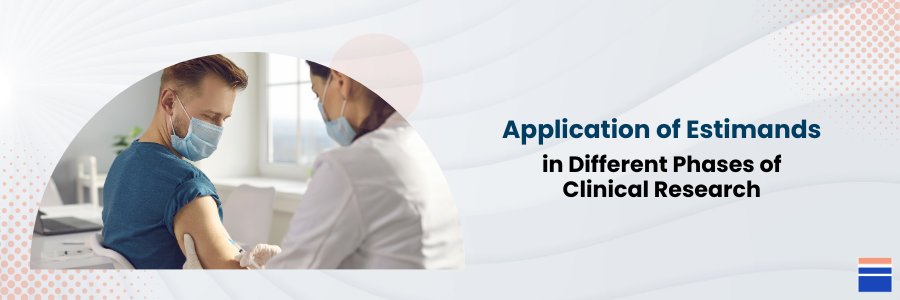Estimands in Clinical Trials

Table of contents
- Understanding Estimands
- Application of Estimands in Different Phases of Clinical Research
- Specifying Estimands for Secondary and Exploratory Endpoints
- Shared Cross-Functional Duties—Should estimand be only defined by biostatisticians?
- Benefits of Preliminary Conversation on Estimands
- Main Impacts of Statistical Analysis
In essence, estimands are not a novel concept to clinical trials. The facets they encompass have been previously addressed, albeit without a structured framework and not always at the planning stage of a clinical trial. This article will delve into 3 critical aspects: the objectives and the prerequisites of estimands and the shared responsibility across functions in their interpretation. Collectively, these elements chart the course of research, impacting its effectiveness, dependability, and ultimately, its success.
Understanding Estimands
The estimand framework described in ICH E9 R1 allows the industry to adopt a common language to discuss important aspects of clinical trials, assists sponsors in planning trials, assists regulators in their reviews and so, enhance the interactions between these parties when discussing the suitability of clinical trial designs and the interpretation of clinical trial results. A clearly defined estimand requires 5 components. As mentioned earlier, none of these components are new. However, 1 notable modification is that these 5 components must now be discussed and agreed upon when planning a clinical trial and clearly defined in the protocol. Before, some components of an estimand were only defined and documented later during the course of a clinical trial. These 5 components are:

1. Treatment Condition
Let’s begin with the first component, the treatment condition. Essentially, it refers to the treatment groups that participants might be assigned to during a clinical trial, such as an active treatment, the placebo, the vehicle, etc.
2. Population
The second component is the population targeted by the clinical trial i.e., participants who meet all inclusion criteria and none of the exclusion criteria.
3. Endpoint
The third element involves clearly defining the endpoint used to address the clinical question to be analyzed e.g.: change from the baseline to Week X, proportion of responders at week X, and so on.
4. Intercurrent Event
The 4th component is the intercurrent events. Essentially, an intercurrent event is any event occurring during the course of the trial that could potentially affect the assessment of the endpoint. This could be an event that prevents data collection, such as a subject being prematurely discontinued from the trial, or an event that casts doubt on the reliability of the collected data.
A good example would be the use of prohibited medication. If a subject is receiving treatment from the clinical trial and concurrently takes a prohibited medication known to affect the efficacy, it becomes unclear whether the observed effects are due to the trial treatment or the prohibited medication. The question then arises: how should we handle such data in our analysis?
Previously, we would consider these events after finalizing the protocol, during the development of the statistical analysis plan (SAP). However, it is now mandatory to identify all intercurrent events and plan how each of them will be addressed in the statistical analysis while planning a clinical trial.
5. Population-Level Summary
The final element is referred to as the population-level summary. Essentially, it is determining which statistics are going to be used to compare the treatment groups e.g., means and standard deviations for continuous endpoints, and number and proportion of participants for categorical endpoints.
Application of Estimands in Different Phases of Clinical Research

The ICH E9 (R1) guidelines do not explicitly state if estimands are required for phases 1 to 3. However, upon reading, it does state that estimands are necessary for any confirmatory trials. This implies any trial that will conclude the drug’s efficacy and whose results will be included in an investigator brochure supporting a new drug application (NDA). As it stands, it is primarily required for phase 2b and phase 3.
Specifying Estimands for Secondary and Exploratory Endpoints
An estimand needs to be defined for the primary efficacy endpoint, referred to as the main estimand. This will influence the trial’s design, conduct, and study analysis. The current practice is to also define an estimand for any secondary endpoint for which the overall alpha level of the study is adjusted. In other words, for any secondary endpoint for which statistical significance will also be claimed and that will contribute to the study conclusion. For other endpoints, like exploratory ones, estimands are currently commonly defined.
Shared Cross-Functional Duties—Should estimand be only defined by biostatisticians?
No!
As previously mentioned, there are 5 elements that must be outlined for an estimand to be fully detailed. The knowledge and expertise needed to define the treatment condition, population, endpoint, and intercurrent events; all of which do not typically come from a biostatistician, but rather from previously published papers and medical input.
The treatment condition, population, and endpoint are usually well defined in the protocol of any clinical trial. A component that requires significant collaboration between Medical Monitors and Biostatisticians in order to be defined appropriately is the intercurrent events and the strategy that will be chosen to handle events in the statistical analyses. Biostatisticians do not necessarily have the expertise to, first, identify such events, and secondly, to properly pre-define how each intercurrent event should be handled in the statistical analysis since the chosen strategy might be based on medical considerations. For example, determining the specific reasons for stopping treatment and identifying prohibited medicals that signal a treatment failure necessitate medical knowledge, not expertise in biostatistics. While it is true that biostatisticians might potentially gain some medical knowledge while working on a particular indication for a significant amount of time, it is always preferable to have a medical opinion in this area.
Benefits of Preliminary Conversation on Estimands
A quick example that comes to mind is risk-based monitoring. As required by ICH E6 (R2), risk-based monitoring must be implemented for all clinical trials and as such, it is no longer required to do 100% source data verification (SDV) for all data collected during a clinical trial. 100% SDV will still be typically performed for data identified as “critical data” during the planning stage of a study. Other data might be monitored using a different strategy, such as central monitoring.
Discussing estimands while designing the protocol design, ensures the team is fully cognizant of all critical data, including intercurrent events. The team then gains a better understanding of the data and events that could significantly impact data reliability of the study results and so, allowing for more effective planning of risk-based monitoring by choosing the appropriate method to monitor critical and other data as well as to mitigate the occurrence of intercurrent events.
This practice enables proactive monitoring, early implementation of mitigation and prevention strategies, rather than reacting after the fact, when it is too late.
Main Impacts of Statistical Analysis
The most significant transformation estimands bring to statistical analysis is the necessity to address them from the outset. Here are the main impacts:
- Estimand requirements are now clearly established.
- Risk-based monitoring is planned with the consideration of critical data and intercurrent events.
- Strategies for handling each intercurrent event are identified based on medical and statistical considerations; this includes how to handle or impute unreliable and missing data for statistical analysis.
As a result, clinical trial results are more reliable, they can now be generalized to the entire target population with greater confidence than ever before.
In sum, the emphasis should remain on the application of estimands across various research phases and the importance of specifying them for secondary and exploratory endpoints. As a whole, estimands enhance the robustness of research, ensuring reliable and meaningful findings, thereby contributing significantly to medical science.
Let’s shape the future of research and make a difference in the industry, gain Innovaderm’s support in your upcoming trial and propel your study to new heights.
About the author
Edith Siméon, M.Sc.
Edith is an accomplished biostatistician, currently serving as Innovaderm’s Associate Director in Biostatistics. She leads a dynamic team, guiding them through various project assignments and fostering a collaborative environment with clients and internal departments. Her expertise lies in applying advanced statistical methods to complex problems, conducting expert reviews, and co-developing training modules. Edith is committed to staying abreast of the latest developments in biostatistics, clinical trial methodologies, and regulatory requirements.
Newsletter
Newsletter subscription resources

